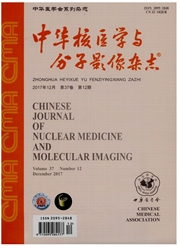

 中文摘要:
中文摘要:
目的 探讨MR酰胺质子转移(APT)成像对胶质瘤与放化疗治疗后改变的鉴别诊断价值,评价APT相关定量指标对二者的鉴别诊断效能.方法 对2014年10月至2015年6月间在华中科技大学同济医学院附属同济医院行APT成像的23例患者(共27个病灶;男15例、女8例,年龄13~80岁)进行前瞻性研究.扫描方案包括头颅常规横断面平扫、弥散WI、增强T1WI、APT成像.定量分析参量包括病灶区磁化转移率(MTR)、磁化转移相对变化率(rMTR),诊断“金标准”为术后病理或影像学随访(随访时间大于3个月).采用Mann-Whitney u检验对数据进行统计学分析.结果 原发(12个)或复发(8个)胶质瘤相比于对侧正常白质区均表现为不同程度的APT对比增强;治疗后改变(7个)的APT信号往往等于或低于对侧正常白质区.胶质瘤与治疗后改变的MTR分别为102.78(101.93,103.84)和100.17(99.94,100.63),差异有统计学意义(z=-3.76, P<0.01);胶质瘤与治疗后改变的rMTR分别为3.92%(2.69%,4.67%)和0.47%(-0.79%,1.11%),差异有统计学意义(z=-3.43, P<0.01).APT定量指标对二者具有良好的鉴别诊断效能,MTR、rMTR的ROC AUC分别为0.986、0.943.MTR取阈值100.68时的诊断灵敏度为100%(20/20),特异性为6/7,准确性为96.3%(26/27);rMTR取阈值1.66%时的灵敏度为95.0%(19/20),特异性为6/7,准确性为92.6%(25/27).结论 结合常规MRI图像,APT成像能为胶质瘤与治疗后改变的鉴别提供良好的定性、定量信息.定量指标MTR、rMTR对二者具有良好的鉴别诊断效能,有望成为评价胶质瘤疗效的无创性指标.
 英文摘要:
英文摘要:
Objective To explore the application of amide proton transfer (APT) imaging in differentiating glioma from treatment effect and to evaluate the diagnostic efficiency of the quantitative APT-related parameters.Methods A total of 23 patients (15 males, 8 females, age: 13-80 years) with 27 lesions who had underwent APT imaging in Tongji Hospital(Wuhan, China) from October 2014 to June 2015 were enrolled in this prospective study.The scan protocols were MRI normal plain scanning, diffusion WI, contrast-enhancement T1WI and APT imaging.Both the magnetization transfer ratio (MTR) and the relative MTR (rMTR) of lesions were manually measured by drawing ROI in the functional post-processing workstation.The results were compared with those of pathologic examinations and radiographic follow-up (≥3 months).Mann-Whitney u test was used to analyze the data.Results Compared with contralateral white matter, the primary gliomas (n=12) and recurrent gliomas (n=8) manifested hyper-intensity, while the treatment induced injuries (n=7) showed iso-or hypo-intensity.The difference of MTR between tumors and treatment effects was significant (102.78(101.93,103.84) vs 100.17(99.94, 100.63);z=-3.76, P〈0.01), so was the difference of rMTR between tumors and treatment effects (3.92%(2.69%,4.67%) vs 0.47%(-0.79%,1.11%);z=-3.43, P〈0.01).Both those two quantitative parameters exhibited excellent diagnostic performance with the AUC of 0.986 and 0.943.The sensitivity, specificity and accuracy of MTR were 100%(20/20), 6/7 and 96.3%(26/27) in the threshold of 100.68, while those of rMTR were 95.0%(19/20), 6/7 and 92.6%(25/27) in the threshold of 1.66%.Conclusions Combined with the routine MRI images, APT imaging can provide excellent qualitative and quantitative information in differentiating glioma from treatment effect.Both MTR and rMTR are helpful for the differentiation with high sensitivity and specificity and can be used as non-invasive imaging biomarkers in
 同期刊论文项目
同期刊论文项目
 同项目期刊论文
同项目期刊论文
 期刊信息
期刊信息
